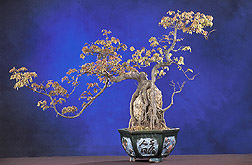This page has been archived and is being provided for reference purposes only. The page is no longer being updated, and therefore, links on the page may be invalid.
USDA Announces Plans for Classical Chinese Garden at Arboretum
By Alfredo FloresAugust 12, 2005
WASHINGTON, Aug. 12—Agriculture Under Secretary for Research, Education and Economics Dr. Joseph Jen today announced the plans for a proposed classical Chinese garden at the U.S. National Arboretum.
"The arboretum's China Garden will be one of the finest of its kind in the world," said Jen. "It will be a great addition to the ten existing world-class display gardens at the arboretum and serve as a reminder of friendship between the Chinese and American people. The China Garden will enhance research in oriental plants and flowers, while providing the public with an opportunity to experience its unique beauty."
Jen and Tom Elias, Director of the U.S. National Arboretum, and Jin Ju, Minister-Counselor for Science and Technology at the Embassy of the People's Republic of China, unveiled details about the proposed garden, which will be named the "China Garden." Jen and Elias have been working closely on this project with the Chinese, since USDA and Chinese Ambassador Yang Jiechi signed a Memorandum of Understanding in October 2004.
The proposed twelve-acre garden plans are based on an original design developed by a joint team of designers from China and the United States. The garden will be split into three main components. One area will include a small pond and traditional Chinese buildings with Ming- and Ching-style hardwood furniture, calligraphy and painting scrolls on the walls, and will feature a traditional boathouse adjacent to a 1.3-acre lake.
The second component will include an exhibition hall for paintings, calligraphy and other Chinese artwork. The third component will comprise a Peony Pavilion overlooking the garden; a Fragrance Pavilion, which will also house authentic Chinese goldfish; and a Whispering Pavilion, which will include a Tibetan white pagoda.
Also today, arboretum officials announced plans to co-host a Chinese Autumn Moon Festival on Saturday, Sept. 17, in collaboration with a local group of Chinese Americans led by Rita Shan. The festival will include tram tours of the arboretum with narratives in both English and Chinese, Chinese food, gourmet tea and moon cakes, performances, and films throughout the evening. The festival also will feature moon viewing, music from Chinese zithers, calligraphy, art displays, stone viewings and lectures on Chinese herbs.
The U.S. National Arboretum covers 446 acres in northeast Washington, D.C. It was established by an act of Congress in 1927 to conduct research, provide education and conserve and display trees, shrubs, flowers and other plants to enhance the environment. It is operated by the Agricultural Research Service, USDA's chief intramural scientific research agency.

